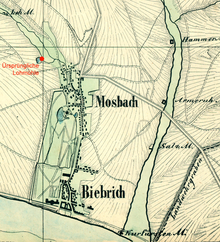Johann Heppenheimer
Johann Heppenheimer (born March 30, 1815 in Biebrich ; † March 13, 1895 ) was a miller, entrepreneur and from 1861 to 1891 mayor of Biebrich am Rhein .
Life
Heppenheimer was born on March 30, 1815 in the Biebrich Kurfürstenmühle . The company, located directly on the banks of the Rhine, came into the possession of his father Peter Heppenheimer (1792–1857) in 1815 , who expanded it with a gypsum distillery and gypsum mill, which ensured a good income, because "gypsum" from clover fields was widespread at the time.
After the death of his father, Johann took over the mill as the only son and expanded the company in the early 1860s with a sawmill and in 1864 bought a steam engine.
In 1861 Heppenheim became mayor and in 1865 he handed over the mill to his son Richard, who continued to run it until 1880.
The consequences of the extensive social and political upheavals after the February Revolution of 1848 , which also affected the Duchy of Nassau like the rest of Europe, fell during Heppenheimer's term of office . After the end of the duchy in 1866 through the Prussian annexation , Biebrich lost its function as a royal seat, but gained in importance through industrial development.
In 1893 Johann Heppenheimer was made an honorary citizen of Biebrich. The Heppenheimerstraße ( ▼ ) in today's Wiesbaden district of Biebrich is a reminder of him.
From the residential to the industrial city

The “Anonymous Nassau Rheinhütte Society” was founded in 1857 to smelt Nassau iron ore . A year earlier, a blast furnace had already been built in Biebrich . The quality of the ore was so bad that the public limited company switched to iron foundry from 1861. The factory was converted into "Schweighöfer Gießerei oHG" in 1865 and taken over by "Heppenheimer & Co." in 1868, which finally sold the company on to Ludwig Beck Senior the following year . The metallurgist had the company, now trading as “Nassauische Rheinhütte”, converted into a successful cupola foundry.
The chemist Heinrich Albert founded a fertilizer factory in Mosbacher Lohmühle, the Chemische Werke Albert, in 1858 . Because of “unhealthy fumes”, the company moved to neighboring Amöneburg in 1861 , which was already on the other side of the state border in the Grand Duchy of Hesse . Germany's largest superphosphate factory was built here until 1871–1873 . In 1893, Heppenheimer sold the neighboring Kurfürstenmühle with adjacent properties to Albert, who already sold them to the city of Wiesbaden in 1895. The merchant HL Kapferer leased the former plaster mill, produced plasterboards there and opened a building materials business.
In August 1863, the aniline paint factory Kalle & Co., founded by the chemist Wilhelm Kalle , began producing fuchsine on the banks of the Rhine in Biebrich , and in 1879 with the production of “ Biebrich scarlet salmon ”. Because of its products, the factory was popularly known as the “red factory”. Seven years after Heppenheimer's death, Kalle leased the remains of the Kurfürstenmühle and incorporated it into the factory premises, which were still growing.
Biebrich-Mosbach
The new factories attracted numerous people from poorer areas, which from 1850 onwards allowed Biebrich and Mosbach to grow together spatially and politically. During Heppenheimer's tenure, the new building of the late classicist town hall in Biebrich by the architect Georg Friedrich Fürstchen was built exactly on the former boundary of the two municipalities . Between 1871 and 1893 the double community officially called itself Biebrich-Mosbach .
Individual evidence
- ↑ Fink, Otto: Local history from Alt-Biebrich. in: Biebrich am Rhein - local history, architectural monuments, memorials and street names. Pp. 27-28. Ed .: Biebrich am Rhein Beautification and Tourist Association, Wiesbaden 1970
- ↑ Reinhardt, Rudolf: Structural change in the iron industry of the Lahn-Dill area. 1840-1914. From iron production to pure iron processing in foundries. , P. 79, Johann Wolfgang Goethe University Frankfurt am Main 1999
- ^ Faber, Rolf: Biebrich am Rhein, 874-1974; Chronicle . P. 132. ed. on behalf of the working group 1100 years of Biebrich. Publisher HG Seyfried . Wiesbaden 1974
- ↑ Schwalbach, Rolf: The mills between Dotzheim and Biebrich . P. 159. Thorsten-Reiss-Verlag . Wiesbaden 2011. ISBN 978-3-928085-57-1
- ^ The communities and manor districts of the province of Hessen-Nassau and their population. Edited and compiled by the Royal Statistical Bureau from the original materials of the general census of December 1, 1871. In: Königliches Statistisches Bureau (Hrsg.): The communities and manor districts of the Prussian state and their population. tape X , 1873, ZDB -ID 1467505-5 , p. 98 f . ( Digitized - listing and footnote Flecken Biebrich-Mosbach).
- ^ Schmidt von Rhein, Andreas: From Biebrich to Wiesbaden: two cities are growing together . S. 17. Ed .: Kur- und Verkehrsverein Wiesbaden . Wiesbaden 1998. ISBN 3-00-003125-1
Web links
- Pictures of the official seat of Heppenheimer, the Biebrich town hall: 1895, still without extension , from 1905/06 , and 2007 .
| personal data | |
|---|---|
| SURNAME | Heppenheimer, Johann |
| BRIEF DESCRIPTION | German entrepreneur and mayor |
| DATE OF BIRTH | March 30, 1815 |
| PLACE OF BIRTH | Biebrich |
| DATE OF DEATH | March 13, 1895 |

